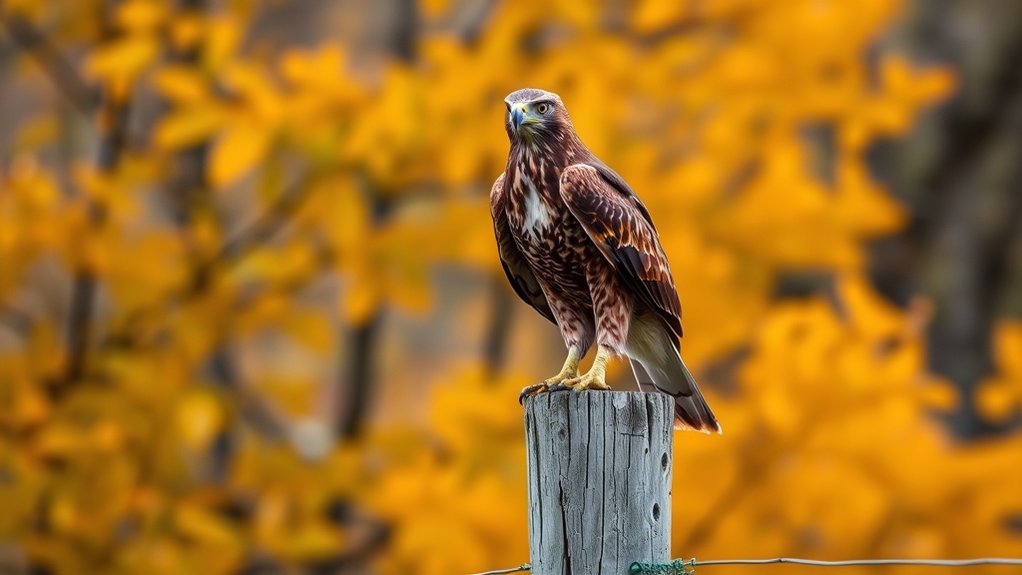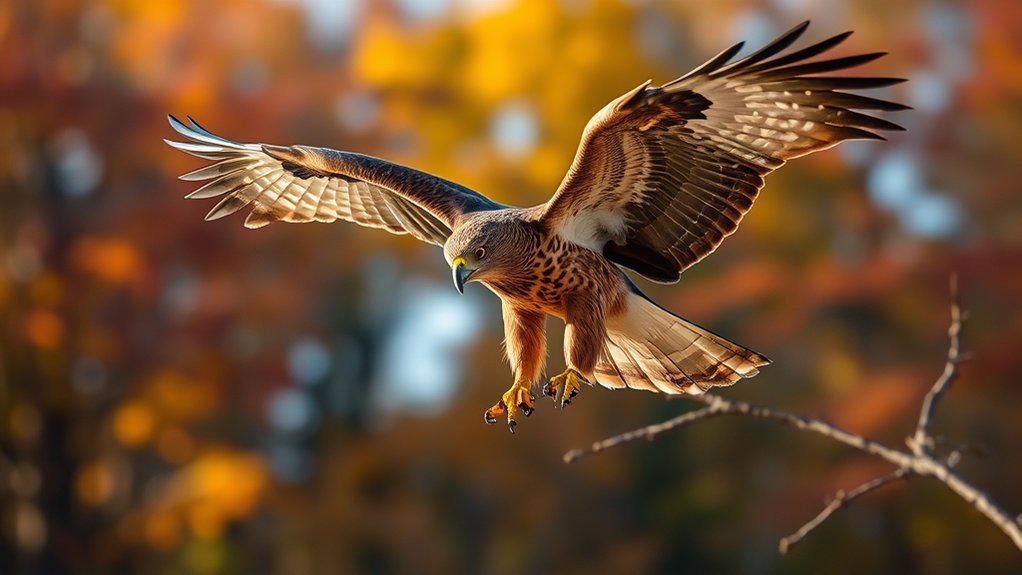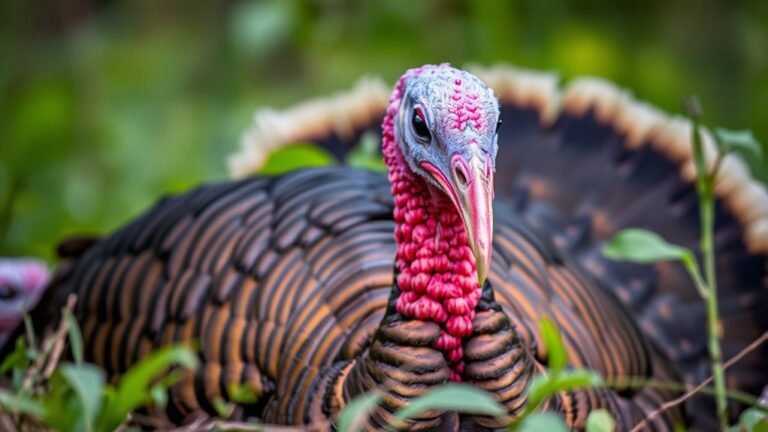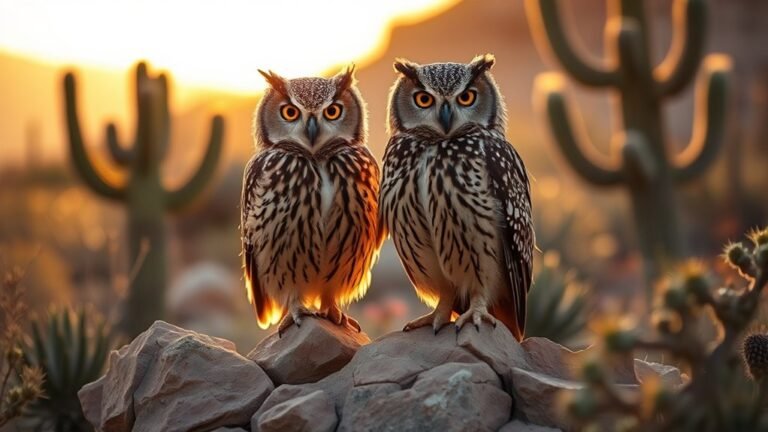Hawks in Massachusetts: Identification and Behavior
If you want to spot hawks in Massachusetts, you'll see many types that are easy to recognize. Each hawk, like the red-tailed hawk or Cooper's hawk, has traits that set them apart. Watching how they hunt and their seasons can help you understand their role in nature. Learning about these hawks can make you appreciate them even more. Let's dive into their amazing lives together!
A Quick Overview
Hawks in Massachusetts: Easy to Spot and Interesting to Watch
In Massachusetts, you can find several types of hawks. The Red-tailed Hawk is one of the most common. It has a reddish-brown tail that makes it easy to recognize. Another hawk you might see is the Cooper's Hawk, which is fast and good at catching smaller animals.
When spotting hawks, look for their size, shape, and colors. For example, the Sharp-shinned Hawk has slate gray feathers, which help identify it.
Red-tailed Hawks love to sit high in trees to watch for their next meal. They like an open view. On the other hand, Cooper's Hawks are good at flying through trees, making them quick hunters.
Hawks build their nests high up in tall trees or on cliffs. Both the mother and father hawk help take care of their eggs, which usually number between one and five.
Many hawks migrate. In late summer, they leave Massachusetts to head south. In spring, they return to Massachusetts to nest and raise their young.
Keep an eye out next time you're outside! Watching hawks can be exciting and fun.
Overview of Hawk Species in Massachusetts

Massachusetts has many kinds of hawks that play important roles in nature. Some of the hawks you can see are the Red-tailed Hawk and the Cooper's Hawk. Each type of hawk likes different places to live.
For example, some hawks enjoy open woods and fields, while others fly over cities. This shows how well hawks can adjust to different homes. Learning about these birds helps us understand how they help the environment.
When you watch hawks in their favorite spots, you appreciate the wildlife around you more. This can also inspire you to help protect these amazing birds and their habitats.
Key Characteristics of Common Hawks

Hawks are amazing birds with many interesting features. When you look at them, you might notice their unique colors. Different types of hawks have different color patterns. For example, the Red-tailed Hawk has a reddish-brown tail, while the Sharp-shinned Hawk is a slate gray. These colors help you tell the hawks apart and let them blend into their surroundings.
The shape of a hawk's wings is also important for recognizing them. Some hawks, like the Cooper's Hawk, have broad wings. This shape helps them fly quickly and easily through trees. Other hawks, like the Red-tailed Hawk, have long, pointed wings. These wings are great for soaring high up in the sky.
Learning about these traits helps you appreciate hawks more and connect with where they live.
Hunting Techniques and Strategies

Hunting birds, like hawks, have different ways of catching their food based on where they live and what type of hawk they are.
For example, Red-tailed Hawks often watch from high places. They look for small animals and then quickly swoop down to catch them.
Other hawks, like Cooper's Hawks, are really fast and can fly through trees to surprise their lunch.
Some hawks dive really fast to catch animals that don't see them coming.
All these different ways of hunting show how these birds can adjust to their surroundings.
Watching them hunt can help you appreciate how skillful they're at staying alive in nature.
If you pay attention to these amazing birds, you'll see how nature works in a beautiful way.
Nesting Habits and Reproduction
Hawks might look like they fly alone, but they've cool nesting habits that help them raise their young. When hawks want to find a mate, they do some impressive flying tricks in the sky. This fun show helps them bond with each other.
Once they make a pair, they start to build a nest. Hawks like to choose high places, like tall trees or cliffs, for their nests. They use sticks, grass, and other things to make a cozy home for their babies.
A hawk usually lays 1 to 5 eggs. Both the mother and father sit on the eggs to keep them warm until they hatch. After the chicks are born, they need their parents for food and protection.
The whole family stays close until the young hawks are ready to fly on their own. Learning about how hawks raise their young makes you appreciate these amazing birds even more!
Seasonal Migration Patterns
As the weather changes, many hawks travel from one place to another. This journey helps them find food and a place to raise their young. Hawks usually migrate in the fall and spring.
In Massachusetts, hawks start their trip south in late summer. They search for warmer places where food is easier to find during winter. They often fly along coastlines or mountain ranges. These paths help them save energy on their long journey.
When spring arrives, they head back north to find their homes. There, they can build nests and raise their chicks.
Best Locations for Hawk Watching
Hawk migration is a great time for bird lovers to see these amazing birds fly by.
If you want to watch hawks, here are some of the best places to go during their migration season:
- Mount Wachusett: This spot has great views for watching hawks in the fall.
- Quabbin Reservoir: The large area here makes it easy to see the hawks as they pass through.
- Blue Hills Reservation: Many people come to this park each autumn to spot migrating hawks.
- Cape Cod National Seashore: The coast is a beautiful place to observe hawks during their migration.
- Middlesex Fells Reservation: This area is known for having different types of hawks to watch.
Grab your binoculars and enjoy the show!
Tips for Identifying Hawks in the Wild
Identifying hawks in the wild is exciting! Here are some simple tips to help you spot them.
First, look at their size and shape. Some hawks are big and broad, while others are smaller and slimmer.
Next, check their colors. Each type of hawk has different markings on its wings and tail.
Use binoculars to scan the sky. This will help you see hawks flying high.
Watch how they move. Some hawks like to soar in circles, while others dive quickly to catch their food. Also, listen for their calls. Different hawks make different sounds, and these sounds can help you know which hawk you see.
Joining a local birdwatching group can be fun! You can learn from other bird lovers and share your own experiences.
With time and practice, you'll feel part of the hawk-watching community.
Get outside and enjoy the thrill of hawk spotting!
Frequently Asked Questions
Can Hawks Be Found in Urban Areas of Massachusetts?
Yes, hawks can live in cities and towns in Massachusetts. They are good hunters and like to eat animals that live in urban areas, such as mice and pigeons. This makes cities a great place for hawks. They can find plenty of food and places to nest. So, if you're out and about, keep an eye out for these amazing birds!
What Do Hawks Eat Besides Small Mammals and Birds?
Hawks eat more than just small mammals and birds. They also catch reptiles, amphibians, and insects. Hawks are great hunters. They can soar high in the sky and quickly swoop down to catch their food. This makes them flexible in different places. Their ability to find various types of food shows how adaptable they are. Whether it's a snake in the grass or a bug on the ground, hawks know how to hunt it down.
How Do Hawks Communicate With Each Other?
Hawks talk to each other in simple ways. They use sounds and calls to share messages. For example, a hawk might screech to warn others of danger.
Hawks also show how they feel with their bodies. They can puff up their feathers, flap their wings, or move in certain ways to help get their point across. This body language helps them stay connected and keep order in their group.
Are There Any Conservation Efforts for Hawks in Massachusetts?
Yes, there are many ways to help hawks in Massachusetts. People work on keeping their homes safe and healthy. These efforts help hawks survive. They also help the community learn about and protect local wildlife. This work is important for both hawks and people.
Do Hawks Have Any Natural Predators in the Wild?
Yes, hawks have natural predators. Larger birds of prey, like eagles and owls, can hunt hawks. These powerful birds can pose a real threat. Hawks also face competition for food from other raptors. This can make survival tough. To stay safe and find food, hawks may change how they hunt. Nature can be challenging for them!

Luna is the passionate founder and author of Birds and You, a website dedicated to sharing her love for birds with fellow enthusiasts. Through her engaging articles and guides, she aims to educate and inspire others to explore the fascinating world of birds. When she’s not writing, you can find Luna observing birds in their natural habitats or sharing beautiful bird photography on Pinterest. Join her on this journey to celebrate and protect our feathered friends!







